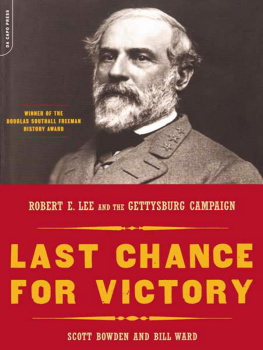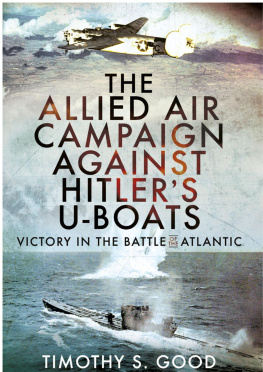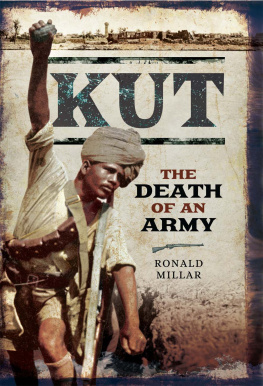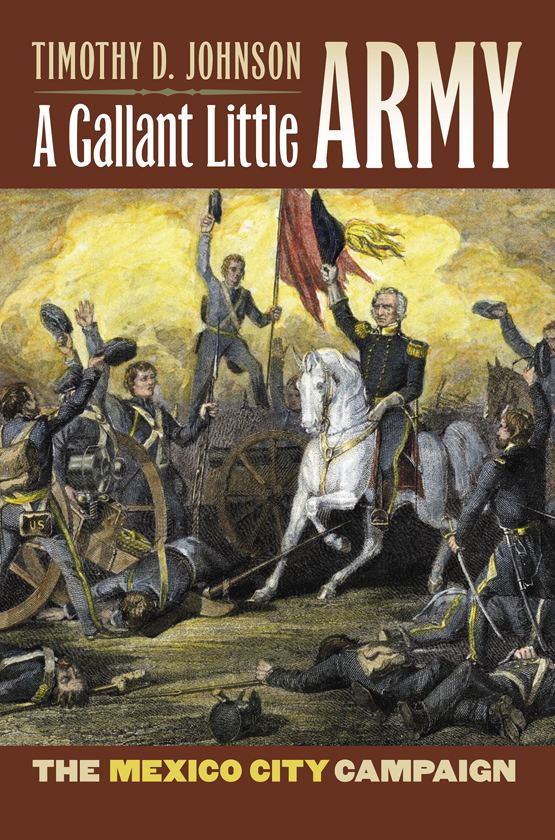A Gallant Little Army
MODERN WAR STUDIES
Theodore A. Wilson
General Editor
Raymond Callahan
J. Garry Clifford
Jacob W. Kipp
Jay Luvaas
Allan R. Millett
Carol Reardon
Dennis Showalter
David R. Stone
Series Editors
A Gallant
Little Army
The Mexico City Campaign
Timothy D. Johnson
University Press of Kansas 
2007 by the University Press of Kansas
All rights reserved
Published by the University Press of Kansas (Lawrence, Kansas 66045), which was organized by the Kansas Board of Regents and is operated and funded by Emporia State University, Fort Hays State University, Kansas State University, Pittsburg State University, the University of Kansas, and Wichita State University
Library of Congress Cataloging-in-Publication Data
Johnson, Timothy D., 1957
A gallant little army : the Mexico City Campaign, 1847 / Timothy D. Johnson.
p. cm. (Modern war studies)
Includes bibliographical references and index.
ISBN 978-0-7006-1541-4 (cloth : alk. paper)
ISBN 978-0-7006-2716-5 (ebook)
1. Mexican War, 18461848Campaigns. 2. Mexico City, Battle of, Mexico City, Mexico, 1847. 3. Scott, Winfield, 17861866. 4. Mexico City (Mexico)HistoryAmerican occupation, 18471848. I. Title.
E405.6.J64 2007
973.62dc22
2007017872
British Library Cataloguing-in-Publication Data is available.
Printed in the United States of America
10987654321
The paper used in the print publication meets the minimum requirements of the American National Standard for Permanence of Paper for Printed Library Materials Z39.48-1992.
For Jayne
A project like this can not be completed without support, both technical and financial, and I have been fortunate enough to benefit from both. I am grateful to Yale University for a 2005 research fellowship that allowed me to mine the rich resources of the Beinecke Library. George Miles, Una Belau, and the rest of the Beinecke staff worked to ensure the success of my tenure there as a research fellow. In addition, I am indebted to the Virginia Historical Society for a 2002 research fellowship, and I especially wish to thank Charles Bryan, Nelson Lankford, Frances Pollard, and Greg Stoner for their valuable assistance. My home institution, Lipscomb University, also provided financial support and I am grateful for help with travel to distant repositories made possible by a David Laine Memorial Award. I especially wish to acknowledge the support of my college dean, Valery Prill.
Other individuals have rendered valuable assistance that warrants recognition and thanks. Kit Goodwin in the Special Collections Division of the University of Texas at Arlington Library, John White in the Manuscripts Division of the University of North Carolina Library, and Ann Lozano and Monica Rivera with the Benson Latin American Collection of the University of Texas at Austin Library made my work in those repositories pleasant and rewarding. To Carolyn Wilson and the following staff members at Lipscomb Universitys Beaman Library, I extent a heartfelt commendation and thanks: Judy Butler, Pam Eatherly, David Howard, Stacy Lusk, Susan Phifer, Rachel Pyle, Eunice Wells, and especially Marie Byers. The aforementioned Beaman staff members have often and graciously helped me locate resources and allowed me special privileges with noncirculating material. I also thank Robert Johannsen for his valuable role as an adjudicator in the early stages of this project. In addition, I am particularly indebted to Richard Bruce Winders for his careful reading of the entire manuscript and for his perceptive and constructive criticism. Few people know as much about the conflict with Mexico as Bruce, and his keen insights saved me from several pitfalls. Al Austelle rendered cordial and crucial aid in his capacity as Director of Instructional Technology at Lipscomb, and Jamie Johnson reproduced the maps and illustrations contained in this book. Maps are crucial to the reader of military history, and all of the maps in this book were reproduced from Donald S. Fraziers excellent encyclopedia The United States and Mexico at War (New York: Macmillan, 1998), which were reprinted by permission of the Gale Group. Finally, for guiding me to places relevant to the Mexico City Campaign during a 1999 visit to Mexico, I thank David Brye, Andres Palacios Garcia, and Leopoldo Lagunes Figuera.
I also benefitted from the moral support of many people whose friendship I cherish. For their advice, encouragement, and in some cases for reading portions of this book in manuscript form, but most of all for the relationships we share, I thank the following people: Bill Collins, Jerry Gaw, Richard Goode, Bonnie Hooper, Robert Hooper, Glenn Johnson, Jennie Johnson, David Lawrence, Marc Schwerdt, Guy Swanson, Dwight Tays, Paul Turner, and Mark Williams. I continue to profit from the wise advice of my friend, Nathaniel Cheairs Hughes. During my periodic visits to Chattanooga, Nat is often gracious enough to sit with me over a cup of coffee and engage in discussions about our respective research projects. I am always the beneficiary of such meetings. Several students in my military history class read and commented on a portion of the manuscript, and I gratefully acknowledge their interest in this project: Finn Breland, Daniel Culbreath, Shaun Grubbs, Ben Ledger, Emily Nix, Gantt Pierce, and Robert Stevens. And thanks also to two more students, Grant Mullins and Reagan Thomas, whose enthusiastic interest in history is infectious.
There are also a host of individuals from my past who probably do not realize the formative influence they have had on me, and although all of their names cannot be mentioned here, their impact is remembered. I especially want to acknowledge four of my former professors and mentors who, despite the passage of two decades, continue to inspire. Howard Jones, Forrest McDonald, James Lee McDonough, and Grady McWhiney were and are scholars worthy of emulation. My parents, Hollis and Bea Johnson, and my sons, Garrett, Griffin, and Graham, have combined to be a great source of encouragement and inspiration. And once again it was a pleasure to work with Mike Briggs, Susan Schott, Larisa Martin, Susan McRory, and the rest of the staff at the University Press of Kansas. They are unfailingly cordial and professional, and especially sensitive to the peculiar quirks of authorsor at least to mine.
I have saved my deepest expression of gratitude for the person to whom I owe the greatest debt. Jayne is my friend, companion, confidant, and wife of twenty-eight years. I have benefitted from her insight, forethought, and wisdom, and I continue to be amazed at her unlimited capacity to love, nurture, understand, and forgive. Through her example, she exerts the kind of influence that makes those around her better. For her support and understanding and for her selfless sacrifices, I say an inadequate thank you. This book is the result of seven years and countless thousands of hours of work, and I dedicate it to her.
Let our people not altogether forget the ten thousand American soldiers who landed at Vera Cruz, the victorious and triumphant march to the capital of Mexico, and which never retreated an inch.
J. Jacob Oswandel, First Pennsylvania Infantry Regiment
Standing atop a hill called El Telgrafo, camera in hand, I scanned the countryside to the northeast. An adjoining hill, La Atalaya, rose directly in front of me, its rounded crest but a few hundred yards from where I stood. Behind it and as far as the eye could see were rows of hills and ridges, all of them green with vegetation. The panorama inspired awe and amazementawe at the beauty of the landscape, and amazement in contemplating how 5,000 American soldiers with artillery in tow traversed that terrain to attack the left flank of the Mexican army. Some of the hills were so steep that the cannon had to be pulled up one side and let down the other by hand with ropes. I was standing at the critical point, the exact location of the Mexican flank on the Cerro Gordo battlefield, site of one of the most important engagements in the United States war with Mexico. Here, on April 18, 1847, a desperate hand-to-hand struggle with muskets and bayonets drenched the crest of the hill with blood and sealed the American victory.







